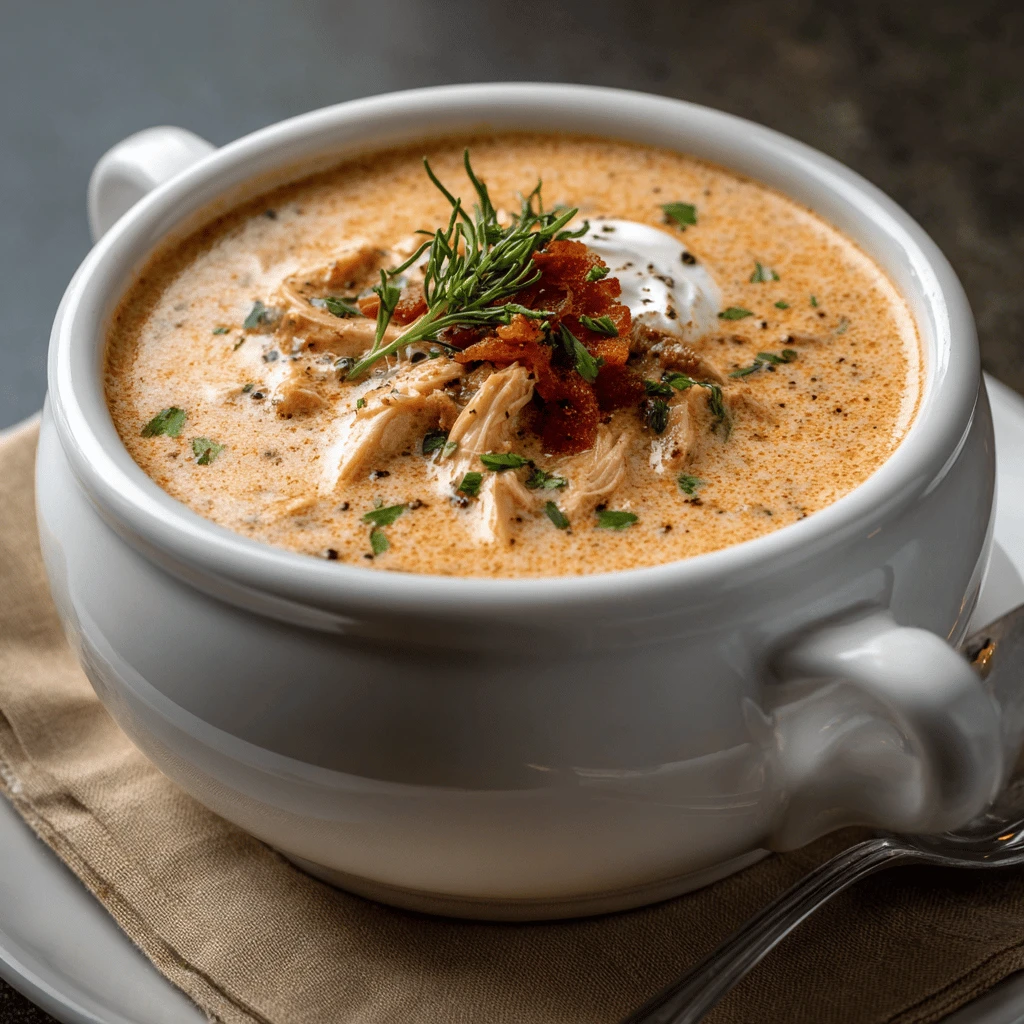Creamy Chicken Bisque: A Comforting Classic
Creamy Chicken Bisque. The very name conjures images of a warm, comforting bowl on a chilly day. More than just a soup, it’s an experience – a symphony of flavors and textures that delights the senses. This article delves into the heart of this beloved classic, exploring its origins, variations, and secrets to creating the perfect creamy chicken bisque at home.
The Allure of Bisque: A Historical Perspective
While the term “bisque” is now widely associated with creamy soups, its origins are far more specific. Historically, bisque referred to a smooth, creamy soup made from crustaceans, such as lobster, crab, or shrimp. The name itself is believed to derive from the Bay of Biscay, a region known for its abundant seafood. The traditional method involved grinding the shells of the crustaceans to thicken the soup and extract their rich flavor.
Over time, the term bisque broadened to encompass creamy soups made from other ingredients, including vegetables and, of course, chicken. The key characteristics that define a bisque remain consistent: a velvety smooth texture, a rich and decadent flavor, and a touch of elegance. The evolution of bisque reflects the changing culinary landscape and the creative adaptations of chefs and home cooks alike.
Mastering the Basics: Essential Ingredients and Techniques
Creating a truly exceptional creamy chicken bisque requires careful attention to detail and a focus on high-quality ingredients. Here’s a breakdown of the essential elements:
- Chicken: The foundation of any good chicken bisque is, naturally, chicken. You can use cooked chicken – leftover rotisserie chicken is a fantastic shortcut – or poach chicken breasts specifically for the soup. Poaching offers a more tender and flavorful result, as the chicken simmers gently in broth infused with aromatics.
- Aromatic Vegetables: Onions, carrots, and celery, known as mirepoix, form the aromatic base for the bisque. Sautéing these vegetables in butter or olive oil until softened releases their natural sweetness and creates a depth of flavor.
- Broth: High-quality chicken broth is crucial. Homemade broth is always the best option, but a good store-bought variety can also work. Look for low-sodium options to control the saltiness of the final dish.
- Dairy: Cream is the key to achieving the signature creamy texture of a bisque. Heavy cream provides the richest flavor and most luxurious consistency, but half-and-half can be used for a slightly lighter option. Some recipes also incorporate milk or even a touch of sour cream for added tanginess.
- Thickening Agent: To achieve the desired thickness, bisques often rely on a roux (a mixture of butter and flour) or a cornstarch slurry. A roux provides a richer flavor, while a cornstarch slurry offers a gluten-free alternative.
- Seasoning: Salt, pepper, and other herbs and spices enhance the flavor profile. Consider adding a bay leaf, thyme, or a pinch of nutmeg for added complexity.
The process of making a creamy chicken bisque involves several key techniques:
- Sautéing the Aromatics: Properly sautéing the mirepoix is essential for building a flavorful base.
- Adding the Chicken and Broth: Simmering the chicken in broth allows the flavors to meld together.
- Blending for Smoothness: The bisque is typically blended until smooth, either with an immersion blender or in a regular blender (in batches).
- Adding the Dairy: The cream is added towards the end of the cooking process to prevent it from curdling.
- Adjusting Seasoning: Taste and adjust the seasoning as needed to achieve the perfect balance of flavors.
Variations and Creative Twists: Personalizing Your Bisque
While the classic creamy chicken bisque is a delight in itself, there are countless ways to personalize it and create unique variations. Here are a few ideas:
- Adding Vegetables: Incorporate other vegetables, such as roasted butternut squash, sweet potatoes, or corn, for added flavor and nutritional value.
- Spice It Up: Add a pinch of cayenne pepper or a dash of hot sauce for a subtle kick.
- Infuse with Herbs: Experiment with different herbs, such as rosemary, sage, or chives, to create unique flavor profiles.
- Top It Off: Garnish your bisque with a variety of toppings, such as croutons, fresh herbs, a swirl of cream, or a sprinkle of paprika.
- Cheese Please: Stir in a little shredded cheddar or parmesan cheese for a richer, more flavorful bisque.
Consider incorporating sherry or white wine into the bisque for complexity. A splash of sherry added just before serving can elevate the flavor. Remember to adjust your cooking times if you add tougher vegetables that take longer to cook, such as raw potatoes or dense root vegetables.
Serving and Pairing: Completing the Experience
The presentation of your creamy chicken bisque is just as important as the taste. Ladle the soup into bowls and garnish with your choice of toppings. Serve with crusty bread or crackers for dipping.
Creamy chicken bisque pairs well with a variety of sides and beverages. A light salad, such as a simple green salad with a vinaigrette dressing, provides a refreshing contrast to the richness of the soup. Grilled cheese sandwiches or panini make excellent accompaniments.
When it comes to beverages, a crisp white wine, such as Sauvignon Blanc or Pinot Grigio, complements the flavors of the bisque. A light-bodied beer, such as a pilsner or a wheat beer, is another good option. For a non-alcoholic choice, try sparkling apple cider or ginger ale.
Troubleshooting Common Issues
Even the most experienced cooks can encounter challenges when making creamy chicken bisque. Here are some common issues and how to address them:
- Soup is too thin: If your bisque is too thin, you can thicken it with a cornstarch slurry or a roux. Alternatively, you can simmer the soup for a longer period of time to allow some of the liquid to evaporate.
- Soup is too thick: If your bisque is too thick, you can thin it out with more broth or cream.
- Soup is curdled: If the cream curdles, it may be because it was added to the soup while it was too hot. To prevent this, add the cream gradually and simmer over low heat. If the cream does curdle, you can try blending the soup again to smooth it out.
- Soup lacks flavor: If your bisque lacks flavor, try adding more salt, pepper, or other herbs and spices. You can also add a splash of sherry or white wine to enhance the flavor.
- Soup is gritty: If your bisque is gritty, it may be because the flour or cornstarch was not properly incorporated. To prevent this, make sure to whisk the flour or cornstarch into a smooth paste before adding it to the soup.
Frequently Asked Questions
Can I make creamy chicken bisque ahead of time?
Yes, you can make creamy chicken bisque ahead of time. In fact, the flavors often meld together and improve after a day or two in the refrigerator.
How long does creamy chicken bisque last in the refrigerator?
Creamy chicken bisque will last for 3-4 days in the refrigerator. Be sure to store it in an airtight container.
Can I freeze creamy chicken bisque?
While you can freeze creamy chicken bisque, the texture may change slightly upon thawing. The cream can sometimes separate or become grainy. To minimize this, cool the bisque completely before freezing it in airtight containers or freezer bags.
Can I make creamy chicken bisque without cream?
Yes, you can make a lighter version of creamy chicken bisque by using half-and-half or milk instead of heavy cream. You can also add a tablespoon or two of sour cream or cream cheese for added richness.
What can I serve with creamy chicken bisque?
Creamy chicken bisque pairs well with a variety of sides, such as crusty bread, grilled cheese sandwiches, and salads.




